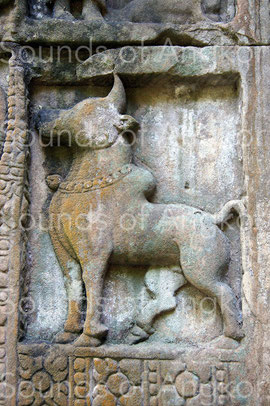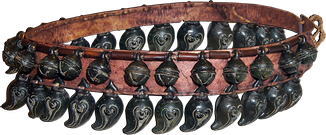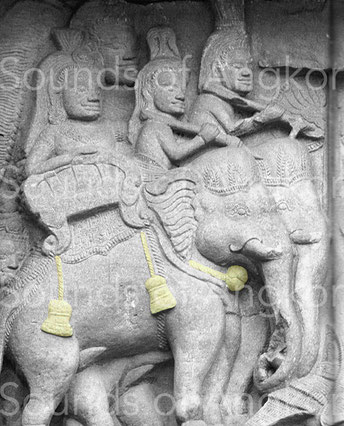Last update: December 3, 2023
The animal bells are present in the iconography: horses, cows and elephants. As many of them were in bronze, numerous objects were found in the archaeological excavations.
Bells of 'open'
There are two types of bells for elephants: bells of 'open' or cup-shaped form and bells of 'closed' or crotal form.
Bells are derived in shape from two basic forms: the cup and the hollow sphere. The cup form, also called the 'open' bell, appears in a great variety in design especially carried by elephants. It was probably carried by cows and buffaloes but the iconography doesn't show them. Today, but formerly probably too, bells of 'open' are made of different materials: bronze, iron, bone, wood, bamboo in different shapes according animals and areas.
Elephant bells of 'open'
Elephants in battle or parade are represented with five bells of 'open': one around the neck and two on each flank. There are as many models as there are representations. The Elephant Terrace conceals several in the round at the scale 1.
Pyramidal bells of 'open'
Bronze pyramidal bells have been discovered in various places in Cambodia and Thailand without it being possible to define their role. Their four faces are smooth or decorated.

Bells of 'closed'
The bells are omnipresent on the bas-reliefs, represented at the neck of cattle, horses and elephants. Archaeological excavations provide many copies. The oldest dates back to the Bronze Age. They are of different sizes, worn unitarily or in collar.
Cow bells of 'closed'
Horse bells of 'closed'
The horses of war are adorned with majestic bell collars. Iconography and archeology bring us many testimonies.
The equine bells are made up of spaced or tight elements, with one or two rows, sometimes a single big central bell. There are spherical, piriform and mango-shaped bells.
In the Elephant Terrace, there is clearly distinguished by the high relief a combination of two bell collars: one composed of spherical bells and the other of mango-shaped bells.
Bells of 'closed' with X-shaped mouth
X-shaped mouth bells are little detectable but rare in the Khmer sculpture. One of them is visible at the neck of a bovid at the Banteay Samre temple.
A rare or even unique representation of a bell around the neck of an elephant is found at the Phnom Rung temple in Thailand. On the other hand, numerous copies of these objects, of all sizes, were found in the excavations. They have some peculiarities:
- They are frequently decorated with floral elements.
- Their periphery is circled by two broad edges separating the resonant part of the bell from the body of the animal.
- An alloy ball similar to the body is trapped in the bell.
- On a few specimens studied, the two broad sections on either side of the X-shaped mouth produce two distinct notes. But given the oxidation of most of the specimens, we cannot generalize.
















